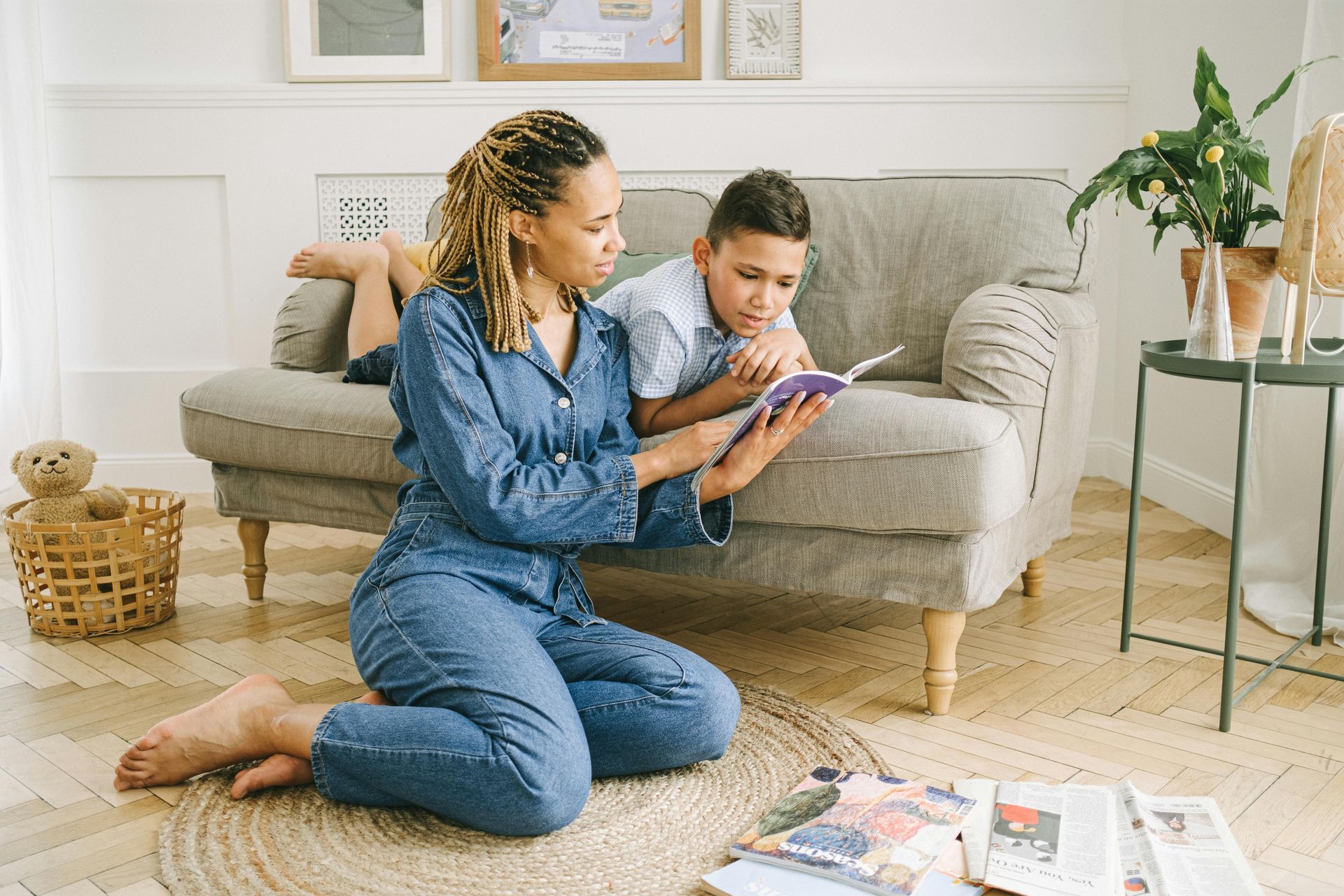Blog
12 Ways to Cultivate Gratitude With Your Kids
Anne Hauth • November 12, 2024
We've arrived at the season of giving thanks--but shouldn't that be every season? Research shows that grateful people are happier and healthier. Here are 12 easy ways to cultivate gratitude with your kids all year long. Click on the links to download free printables!
- Keep a stack of these
Gratitude Cards in a central area of your house. Anytime your child has someone to thank, encourage them to fill out a card!
- Play Gratitude BINGO. Download these
printable BINGO Cards and
instructions for playing. The BINGO Cards are an interactive PDF, so you can type on them before printing if you wish.
- Keep a family Gratitude Journal. At the end of each day, ask your kids what they were thankful for that day. Write their thoughts in the journal. Encourage your kids to think of things specific to the day, and ask them to try not to repeat things from previous days. This practice will help them notice that there are new things to be thankful for each day.
- Download this
Gratitude Scavenger Hunt and have kids complete this activity with friends, classmates, or neighbors. Design your own scavenger hunt using this
interactive PDF with different items, so you can play as much as you’d like.
- Decorate your home with a Gratitude Tree. Create the tree by drawing branches on a poster board or by standing real twigs in a pot or vase. Have kids write their gratitudes on the
Gratitude Leaf Cards and add them to the tree. Hopefully you'll be adding branches all year long as your kids think of more and more reasons to give thanks.
- Take a Gratitude Walk. Walk outdoors with your kids, and have them carry a notebook and pen. Ask them to be quiet during the walk. Have them notice and write down what feels good and what they appreciate about being outdoors. After the walk, ask them to elaborate, either verbally or in writing, on what they wrote down.
- The books on this
Gratitude Book List are all about giving thanks. Whether you're looking for picture books to read aloud to younger kids or chapter books that inspire reflection in your older kids, this list has dozens of fantastic titles.
- Sometimes the simplest questions can lead to the most profound answers. Use these
Gratitude Conversation Starters to prompt thoughtful discussions in your family.
- Do a daily Gratitude Meditation. Have kids close their eyes and think about the word “thankful” for a quiet minute each day. When they open their eyes, have them write down, tell you, or simply reflect for a moment on the things that came to mind.
- Have kids write what they’re thankful for on little slips of paper. Have them put the papers in a jar or add them to a bulletin board.
- Be a role model. Offer your own reflections whenever you feel thankful for something.
- Take pictures of the things your kids are grateful for. Print the pictures to make a Gratitude Collage to display in your home.
P.S. We are thankful for YOU! Thank you for all you do to help your kids become better readers. Please connect with us if One Minute Reader can support you in any way.
Highlighted Posts

The other day, my son asked me why blizzards are hazardous. The most interesting part of his question was the way he said the word hazardous. He pronounced it incorrectly, with a long a: HAYzardous. This told me he’d never heard the word spoken aloud before. However, when I probed him on the word’s meaning, he knew it exactly. How? He came across the word in a book he was reading. He didn’t know what it meant, but he figured out the meaning using context clues. Sometimes an unknown word can stop a reader in their tracks, shutting down comprehension. But if the reader has the ability to figure the word out, comprehension can continue, and the new word becomes part of the reader’s vocabulary. According to the research, vocabulary and comprehension are strongly linked. Students with low vocabulary scores tend to have low comprehension, and vice versa. Students acquire vocabulary incidentally through exposure to words at home and at school—by listening and talking, by reading books with adults, and by reading widely on their own. Students, especially struggling readers, also benefit greatly if they are taught strategies for vocabulary acquisition. Vocabulary activities should aim to engage students in actively thinking about word meanings, the relationships among words, and how we can use words in different situations. Effective strategies for vocabulary practice include: Student-Friendly Definitions : The meaning of a new word should be explained to students at their level, rather than just providing a dictionary definition. Defining Words Within Context : The most effective time to introduce an unknown word’s meaning is often at the moment the reader meets the word in the text. Using Context Clues : Students should learn to infer the meaning of a word by looking closely at surrounding text. Sketching Words : For many students, it is easier to remember a word’s meaning by making a quick sketch that connects the word to something personally meaningful to the student. Applying Words : When students are challenged to apply new words to their own experiences, they have another opportunity to deeply process its meaning. Analyzing Word Parts : If students know the meanings of root words and affixes, they are more likely to understand a word containing these word parts. Semantic Mapping : Semantic maps help students develop connections among words—for example, by writing an example, a non-example, a synonym, and an antonym. Developing Word Consciousness : Students who are word conscious are aware of and interested in the words around them. Teachers can promote word consciousness by helping students use: Language categories: Students learn to make finer distinctions in their word choices if they understand the relationships among words, such as synonyms, antonyms, and homographs. Figurative language: The ability to use figures of speech is also a part of word-consciousness. The most common figures of speech are similes, metaphors, and idioms. We’ve strongly incorporated vocabulary development into One Minute Reader . If your child is using One Minute Reader, there are many ways for them to build vocabulary and increase comprehension: During the Cold Read step, they should click on unknown words to hear the words pronounced immediately. During the Read Alone step, they should click on highlighted vocabulary words to see and hear the definitions. They can also use our free Difficult Word List resource to sketch and record words they struggled with so that they may review them later. For targeted, game-based vocabulary practice, check out the Splat-O-Nym iPad app . With audio support and immediate feedback, Splat-O-Nym helps students learn pronunciation and enhance their vocabulary acquisition through fun activities. The app includes over 7,000 synonym questions, 1,000 antonym questions, and 600 meaning-from-context questions. After I answered my son’s question about blizzards, I high-fived him for figuring “HAYzardous” out as he read. At One Minute Reader, we're here to help you mitigate the hazards of low vocabulary and ensure your child has the tools they need to become a successful reader.

Regardless of where kids are on their reading journey, there are countless ways to incorporate reading into cozy days at home this winter. Here are some easy ideas for kids to try at home over winter break and beyond! Have kids think of the trusted friends, family members, or adults in their lives who can read, and encourage them to read aloud with these people as often as possible. Depending on their reading ability, they can simply listen to a book read aloud, or they can take turns reading and being read to. Have the kids fill out this Read-Aloud Log every time someone reads to them or every time they read to someone. You could offer a small reward for completing this activity every day of winter break (or every day during a predetermined time period). Reading aloud to their pets, stuffed animals, or even to themselves counts too! Set up reading challenges in which kids set goals and record their minutes spent reading or the number of books they read. Have kids color and decorate these winter-themed bookmarks to make reading even more fun. Encourage kids to borrow books from the library and have a big pile to choose from on cozy winter days. See this Cozy Wintertime Book List for book ideas. Refer to our 7 Ways to Create a Cozy Reading Environment document to create an ideal reading space. Lend or gift kids the first book in a series that’s likely to hook them. Sometimes all it takes is the right series to turn a reluctant reader into a bookworm! Incorporate reading time into other fun activities. For example, while making dinner or baking holiday treats, kids can read the recipes and write out the grocery lists. Create a snowflake book wall. Print out this Snowflake Wall Template , and have kids fill out a snowflake each time they finish a book. Then, have them tape the snowflake to the wall. Encourage kids to find ways to read while playing favorite games or while spending time on electronic devices. While playing games, have them read the game instructions aloud. While watching shows, have them turn on and read the subtitles. Have kids practice reading and writing while completing this fun Winter Scavenger Hunt . They’ll get some fresh air too! Refer to this Send Some Cheer printable for addresses to places where kids can send letters. Have them practice their writing skills and spread kindness by writing to kids in hospitals, senior citizens, refugee children, and more. Set up daily One Minute Reader time, and see literacy progress in just minutes! This research-proven, parent-trusted program is free for 7 days and just $8/month after that. Your kids will have so much fun beating their goals, they won't want to stop. Download the Splat-o-Nym vocabulary iPad app , which keeps kids entertained while boosting their vocabulary. Kids can try a free version of this game and purchase to get the full experience. Note that this app is only available for iPads, not smartphones or other devices. Add your own ideas to this list! Our hope is for all kids to experience the joy of reading this winter season and always.
Ready to see an improvement in your child's reading?
Sign up today and get seven days for FREE.
One Minute Reader is just $8 per month after your free trial.
